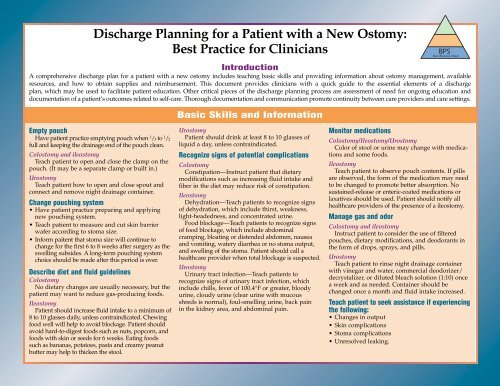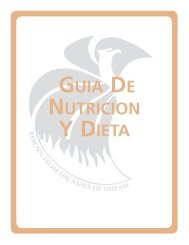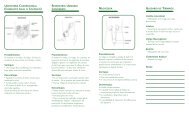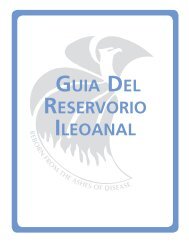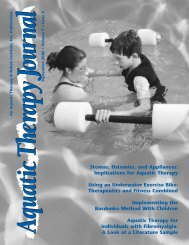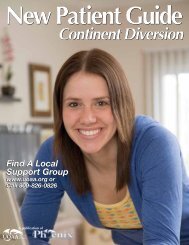Ostomy chart - United Ostomy Associations of America
Ostomy chart - United Ostomy Associations of America
Ostomy chart - United Ostomy Associations of America
Create successful ePaper yourself
Turn your PDF publications into a flip-book with our unique Google optimized e-Paper software.
Discharge Planning for a Patient with a New <strong>Ostomy</strong>:<br />
Best Practice for Clinicians<br />
BPS<br />
Best Practice Sheet<br />
Introduction<br />
Acomprehensive discharge plan for a patient with a new ostomy includes teaching basic skills and providing information about ostomy management, available<br />
resources, and how to obtain supplies and reimbursement. This document provides clinicians with a quick guide to the essential elements <strong>of</strong> a discharge<br />
plan, which may be used to facilitate patient education. Other critical pieces <strong>of</strong> the discharge planning process are assessment <strong>of</strong> need for ongoing education and<br />
documentation <strong>of</strong> a patient’s outcomes related to self-care. Thorough documentation and communication promote continuity between care providers and care settings.<br />
Empty pouch<br />
Have patient practice emptying pouch when 1 /3 to 1 /2<br />
full and keeping the drainage end <strong>of</strong> the pouch clean.<br />
Colostomy and ileostomy<br />
Teach patient to open and close the clamp on the<br />
pouch. (It may be a separate clamp or built in.)<br />
Urostomy<br />
Teach patient how to open and close spout and<br />
connect and remove night drainage container.<br />
Change pouching system<br />
• Have patient practice preparing and applying<br />
new pouching system.<br />
•Teach patient to measure and cut skin barrier<br />
wafer according to stoma size.<br />
•Inform paitent that stoma size will continue to<br />
change for the first 6 to 8 weeks after surgery as the<br />
swelling subsides. A long-term pouching system<br />
choice should be made after this period is over.<br />
Describe diet and fluid guidelines<br />
Colostomy<br />
No dietary changes are usually necessary, but the<br />
patient may want to reduce gas-producing foods.<br />
Ileostomy<br />
Patient should increase fluid intake to a minimum <strong>of</strong><br />
8 to 10 glasses daily, unless contraindicated. Chewing<br />
food well will help to avoid blockage. Patient should<br />
avoid hard-to-digest foods such as nuts, popcorn, and<br />
foods with skin or seeds for 6 weeks. Eating foods<br />
such as bananas, potatoes, pasta and creamy peanut<br />
butter may help to thicken the stool.<br />
Basic Skills and Information<br />
Urostomy<br />
Patient should drink at least 8 to 10 glasses <strong>of</strong><br />
liquid a day, unless contraindicated.<br />
Recognize signs <strong>of</strong> potential complications<br />
Colostomy<br />
Constipation—Instruct patient that dietary<br />
modifications such as increasing fluid intake and<br />
fiber in the diet may reduce risk <strong>of</strong> constipation.<br />
Ileostomy<br />
Dehydration—Teach patients to recognize signs<br />
<strong>of</strong> dehydration, which include thirst, weakness,<br />
light-headedness, and concentrated urine.<br />
Food blockage—Teach patients to recognize signs<br />
<strong>of</strong> food blockage, which include abdominal<br />
cramping, bloating or distended abdomen, nausea<br />
and vomiting, watery diarrhea or no stoma output,<br />
and swelling <strong>of</strong> the stoma. Patient should call a<br />
healthcare provider when total blockage is suspected.<br />
Urostomy<br />
Urinary tract infection—Teach patients to<br />
recognize signs <strong>of</strong> urinary tract infection, which<br />
include chills, fever <strong>of</strong> 100.4°F or greater, bloody<br />
urine, cloudy urine (clear urine with mucous<br />
shreds is normal), foul-smelling urine, back pain<br />
in the kidney area, and abdominal pain.<br />
Monitor medications<br />
Colostomy/Ileostomy/Urostomy<br />
Color <strong>of</strong> stool or urine may change with medications<br />
and some foods.<br />
Ileostomy<br />
Teach patient to observe pouch contents. If pills<br />
are observed, the form <strong>of</strong> the medication may need<br />
to be changed to promote better absorption. No<br />
sustained-release or enteric-coated medications or<br />
laxatives should be used. Patient should notify all<br />
healthcare providers <strong>of</strong> the presence <strong>of</strong> a ileostomy.<br />
Manage gas and odor<br />
Colostomy and ileostomy<br />
Instruct patient to consider the use <strong>of</strong> filtered<br />
pouches, dietary modifications, and deodorants in<br />
the form <strong>of</strong> drops, sprays, and pills.<br />
Urostomy<br />
Teach patient to rinse night drainage container<br />
with vinegar and water, commercial deodorizer/<br />
decrystalizer, or diluted bleach solution (1:10) once<br />
a week and as needed. Container should be<br />
changed once a month and fluid intake increased.<br />
Teach patient to seek assistance if experiencing<br />
the following:<br />
• Changes in output<br />
• Skin complications<br />
• Stoma complications<br />
• Unresolved leaking.
Referrals<br />
•Follow-up care in community<br />
• Home health agency<br />
•Support group/visitor<br />
<strong>United</strong> <strong>Ostomy</strong> Association (UOA)<br />
(800) 826-0826<br />
www.uoa.org<br />
Association benefits include:<br />
• Contact information <strong>of</strong> local group<br />
• <strong>Ostomy</strong> Quarterly magazine subscription<br />
•Volunteer visitation<br />
Wound, <strong>Ostomy</strong> and Continence Nurses Society<br />
(888) 224-WOCN<br />
www.wocn.org<br />
Society can provide location <strong>of</strong> nearest WOC(ET)<br />
nurse<br />
Provide patient with the following:<br />
• Supplies sufficient for a minimum <strong>of</strong> two<br />
complete pouch changes at home. (Check with<br />
your facility as the policy may vary.)<br />
•Astarter kit or other complimentary supplies<br />
available from a manufacturer. A patient/family<br />
member or healthcare pr<strong>of</strong>essional with patient’s<br />
permission may contact a manufacturer and have<br />
these gifts sent directly to the home.<br />
• List <strong>of</strong> equipment needed. Some insurers will<br />
require a prescription.<br />
• Size <strong>of</strong> stoma when discharged and pattern<br />
for an irregular-shaped stoma.<br />
Resources<br />
Manufacturer toll-free helplines<br />
Coloplast<br />
800/533-0464<br />
www.us.coloplast.com<br />
ConvaTec<br />
800/422-8811<br />
www.convatec.com<br />
Cymed<br />
800/582-0707<br />
www.cymed-ostomy.com<br />
Hollister<br />
800/323-4060<br />
www.hollister.com<br />
Marlen<br />
216/292-7060<br />
www.marlenmfg.com<br />
Nu-Hope<br />
800/899-5017<br />
www.nu-hope.com<br />
Supplies<br />
Medicare<br />
• Patients can generally obtain equipment from any<br />
supplier.<br />
• Some suppliers may accept Medicare reimbursement.<br />
• Some suppliers will bill Medicare directly, which<br />
is generally viewed as a benefit.<br />
•Those patients receiving home health care may<br />
not be able to bill Medicare for supplies until they<br />
are discharged from home health care.<br />
Private insurance (including Medicaid or<br />
equivalent)<br />
Patient may need to obtain supplies from a preferred<br />
provider; check with insurance company.<br />
This document was developed by the Wound, <strong>Ostomy</strong> and Continence Clinical Practice <strong>Ostomy</strong> Subcommittee.<br />
Perma-Type<br />
800/243-4234<br />
www.perma-type.com<br />
Torbot<br />
800/545-4254<br />
www.torbot.com<br />
Other resources<br />
<strong>America</strong>n. Cancer Society<br />
www.cancer.org<br />
Crohn’s and Colitis Foundation<br />
www.ccfa.org<br />
Familial Adenomatous Polyposis (FAP) Support<br />
Group<br />
www.fapsupportgroup.org<br />
Interstitial Cystitis Association<br />
www.ichelp.com<br />
National Institute <strong>of</strong> Diabetes and Digestive and<br />
Kidney Diseases<br />
www.niddk.nih.gov<br />
Uninsured<br />
• Some manufacturers have a program for free<br />
supplies; check with the company for eligibility.<br />
•Alocal cancer society, <strong>United</strong> <strong>Ostomy</strong> Association,<br />
or supplier may have donated supplies.<br />
•Apatient/family member or healthcare pr<strong>of</strong>essional<br />
with patient’s permission (if consistent with facility’s<br />
infection control and regulatory policy) can contact<br />
any <strong>of</strong> these sources.<br />
Copyright© 2004 by the Wound, <strong>Ostomy</strong> and Continence Nurses Society. This document may be reproduced noncommercially for educational purposes.<br />
The information and recommendations in this publication are not a substitute for personal medical advice or diagnosis.<br />
WOCN Society • 4700 W. Lake Avenue • Glenview, IL 60025-1485 • 888/224-9626 • www.wocn.org


